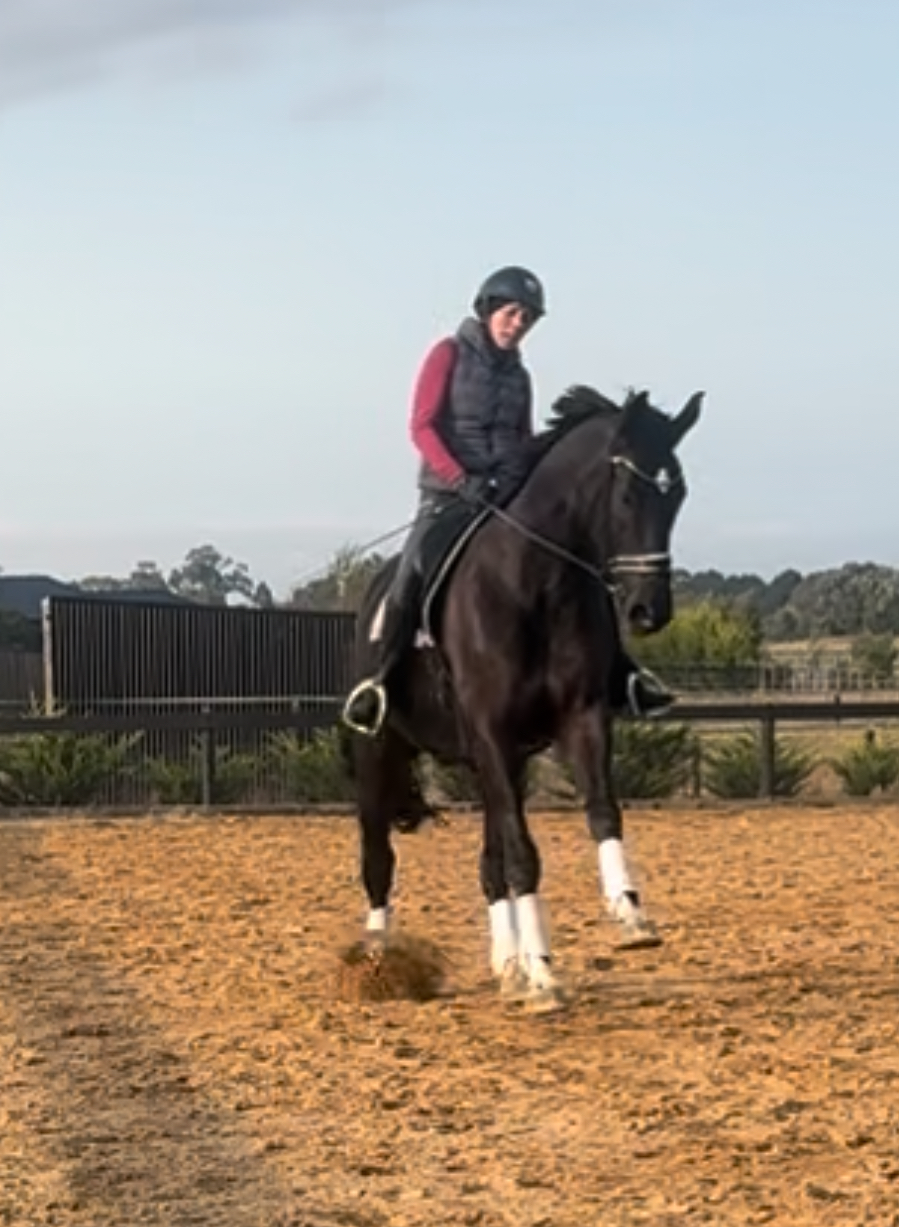Welcome to video blog episode 94, and the first video in my eight-week series on the Rider Habits that can transform your confidence, performance, and enjoyment in the saddle. In this blog, we’re exploring one of the simplest yet most powerful tools you have as a rider: your breath, and specifically a dressage breathing habit you can use to improve your canter transitions.
Watch the video below, starring my daughter!
Why Breathing is a Dressage Rider’s Secret Weapon
Breathing might sound basic, but it is one of the most effective ways to calm nerves, improve focus, and build connection with your horse. Too often, riders only think about their breathing when they’re nervous or when their horse is tense. But breathing well isn’t just for “problem moments” — it’s a skill that can enhance every ride, especially when it comes to smooth transitions and harmony with your horse.
When used intentionally, breathing can:
- Relax your seat and soften your body
- Diffuse nerves or tension before a movement
- Help your horse stay supple, expressive, and connected
- Encourage lighter, more responsive transitions
The Dressage Breathing Habit Exercise for Canter Transitions
The habit I want you to try this week is simple but powerful: breathe out as you ask for canter.
Here’s how to do it:
- Prepare for canter as you normally would.
- Take a deep breath in through your nose.
- As you give your canter aid, breathe out fully through your mouth.
This creates a natural release in your body, helping you relax your seat, soften your hands, and flow with your horse into the transition.
Why This Works
This simple breathing habit has three key benefits for riders:
1. Reduces Nerves
If you feel anxious about cantering — or if your horse tends to get tight or excitable — breathing out helps release tension in your body. A big audible exhale can even relax your horse as they hear and feel your calmness.
2. Creates Softer Transitions
Horses mirror us. When you soften through your seat and hands by breathing out, your horse is more likely to relax into a smooth and balanced transition instead of hollowing or resisting.
3. Encourages Lighter Aids
Over time, this exercise allows you to ask for canter with less effort. By combining your breath with a light aid, your horse begins to respond more willingly and attentively. This is the essence of dressage — achieving more expression and connection with less pressure.
How to Practise Your Dressage Breathing Habit
Start by using this dressage breathing habit every time you ask for canter. You may also find it helpful in other transitions or when you feel yourself getting tense. If you’re competing, practice it at home so it becomes second nature when the pressure is on.
A tip for remembering: set a reminder on your phone, write a note on your saddle, or even place a sticky note on your bridle bag so that when you tack up, you’re reminded to practise your breathing habit.
Take the Exercise Beyond the Saddle
You don’t have to wait until you’re riding to develop this habit. Practise exhaling slowly whenever you feel nervous or tense in daily life. The more you train your body to link relaxation with your breath, the easier it will be to access this tool in the arena.
Your Challenge This Week
In your next ride, consciously breathe out as you ask for canter. Notice how it changes your body, your horse’s response, and the overall feel of your ride. Do this consistently for a few rides and you’ll start to feel the difference in both confidence and connection.
Why Habits Like This Matter
Small habits, practised consistently, make the biggest difference to your long-term riding success. Whether your goal is to compete, move up the levels, or simply enjoy riding with more confidence, building habits like intentional breathing gives you reliable tools to bring out the best in yourself and your horse.
Further Reading on Breathing and Performance
If you’d like to learn more breathing techniques, check out this article from The Everyday Equestrian – 6 simple breathing techniques to reduce anxiety and nerves when riding your horse. While not horse-specific, the principles are highly relevant for riders managing nerves or seeking calm focus.
Want More Tips Like This?
If you found this breathing habit useful, you’ll love the other mindset and performance strategies I share. For more practical tools to boost your confidence and focus in the arena, sign up for my free rider’s guide here: click here to access the guide. It’s packed with simple, effective exercises you can use to prepare for your next training session or competition.
Final Thoughts
The Dressage Breathing Habit is one of the simplest yet most effective rider tools you can implement. By linking your breath to your canter transitions, you’ll create calmness, softness, and connection in your riding. Give it a try this week and notice the difference it makes.

